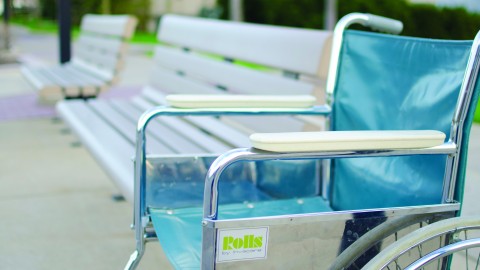By Gabrielle Fellows

With recent advancements in medicine and technology, the quality of life for disabled individuals has improved drastically. However, in order for disabled individuals to fully enjoy this higher quality of life, their environments must also reflect the advancements in disabled care.
While many Youngstown State University students with disabilities are taking advantage of the services the campus provides, certain environmental factors still hinder some students’ mobility.
YSU’s Disability Services, housed under the Marion G. Resch Center for Student Progress, has helped address some of the issues that YSU students might have concerning the program’s care.
While there have been multiple complaints to the offices concerning repairs to buildings, bathrooms, parking lots and automatic door openers, the staff said that they are satisfying and exceeding the regulations set for universities by the Americans with Disabilities Act of 1990.
The Americans with Disabilities Act is an act of law that prohibits the discrimination against people with any sort of handicap. The law prohibits discrimination against disabled people in employment, public accommodations, government activities and communication.
This act is responsible for creating guidelines that all public buildings and works must follow.
William Spencer, the staff architect in the university facilities department, is in charge of making sure the university meets not only the ADA guidelines, but also a specific set of regulations called the Ohio Building Code. He states that everything that can be done for the students is done for the students, but many don’t recognize it.
“We’ll get complaints concerning the automatic door openers not working or the bathrooms not being big enough for certain wheelchairs,” Spencer said. “What many don’t know is that the automatic door openers aren’t required in the guidelines — we just do it to go above and beyond for our students. When the majority of YSU was built, there were no ADA codes. There was no specification for isle widths for wheelchairs or specialty wheelchairs. We’re making a lot of renovations over the summer, but sometimes older buildings and areas make it difficult to [create better] accessibility.”
Gina McGranahan, assistant director of the department of disability services, said that while disability services does meet and mostly exceed the ADA guidelines, some aspects of its services might not guarantee total student satisfaction.
“We are in compliance with ADA, as in door sizes and all that kind of stuff. But a lot of things are bigger than what’s in the code. … Wheelchairs were thinner [back when the codes were created], [and now] there are scooters that are bigger and they can’t fit into bathrooms at all; it’s too small … [but] it’s hard to retrofit buildings,” McGranahan said. “But when the university does do new construction, we go above and beyond to make sure we meet and exceed the need of these students.”
While disability services has no direct power in overseeing renovations or additions to the university, McGranahan said that she receives all complaints before sending them out to Spencer and the grounds and maintenance teams, who are responsible for repairs and add-ons to the university.
“Students think certain things have to be done and then wonder why they’re not done … but they [aren’t required],” McGranahan said.
McGranahan said the staff at disability services and their counterparts ensure the best care be given to students, but she said that she feels many students turn their heads when they hear the word disability.
“We have about 700 students registered here and about 8 percent of the population have some sort of disability, so there should be a lot more students registered here … [but] when [students] see the [word] disability … the traditional-age student still has the [negative stigma] concerning disabilities,” McGranahan said.
Disability services exists to work with the university and the state to provide the most accessible and handicap-friendly campus possible, but Spencer said that due to the age of many of the buildings, progress is achieved one step at a time.
“Considering that [the ADA code] was not developed until 1991 and not enforced until 2002, it becomes apparent as to why buildings constructed prior to this time often do not meet the standards that have come to be expected. It is our standard practice to incorporate improvements to existing conditions whenever possible during renovation projects,” Spencer said. “However, there will always remain conditions that are either physically or fiscally infeasible to rectify, in which case we strive to provide alternative solutions to help bridge the gap between accessible and noncompliant conditions.”
The disability services website was recently revamped to meet new ADA guidelines. Anyone looking for more information on these guidelines can visit the website.
